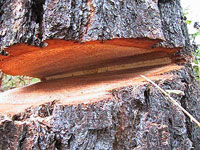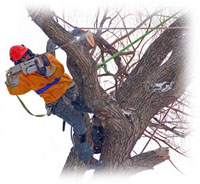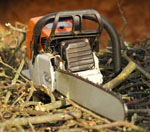Frequently Asked Questions
TREE FALLING
 Q: If I make a pie cut in the front of the tree and then cut the back of the tree it will fall in the direction the pie cut is pointing. Right?
Q: If I make a pie cut in the front of the tree and then cut the back of the tree it will fall in the direction the pie cut is pointing. Right?
A: Not necessarily...
Yes, we know there is a section in the owners manual of that new chainsaw you just bought that tells you all about tree falling. But all trees are different, and there are many things to be taken into consideration that are not covered in that leaflet. We have seen many cases over the years where homeowners have fell trees on their houses, their cars, themselves and through street wires. Tree falling is an art form in itself, not to be underestimated.
THE LADDER AND THE CHAINSAW
Q: I will just lean my extension ladder up against this big limb and cut the end off of it. right?
A: Ladder and chainsaw are two words that do not belong in the same sentence.
When you cut the heavy end of the limb off, the limb raises up past the top of the ladder, the ladder falls out, leaving you hanging in space with a running chainsaw. This is not a cartoon, you and your saw will not hang in mid-air for long. Okay, you say I have this painters ladder, I can use that. right? Not really... A four legged painters ladder is made for even, hard surfaces like floors. When used on lawns or uneven ground just climbing it is a danger, yet alone trying to use a chainsaw while doing your balancing act. Well then I have this nifty three legged pruning ladder, which is made for this right? Not necessarily... Three legged pruning ladders are made for uneven ground and can be made quite stable on rough terrain, but they are made for pruning smaller limbs with pruning loppers and hand saws. When cutting bigger limbs using a chainsaw, the heavy end of the limb tips down coming into contact with the ground first, then the butt of the limb drops towards you knocking your ladder out from under you. Then you become a flying aerial act, juggling a running chainsaw.
PRUNING
 Q: Will pruning hurt my tree?
Q: Will pruning hurt my tree?
A: Through the use of properly trained professionals and utilizing sound pruning techniques, this work will not compromise the health of trees.
Q: What is the difference between topping and pruning?
A: Topping is the excessive and arbitrary removal of all parts of the tree above and beyond a certain height with no regard for the structure or growth pattern of the tree. Pruning is the selective removal of certain limbs based on the structure and growth pattern of the tree.
Q: What is pruning a tree?
A: Pruning is the cutting or removing branches or parts of trees or for improving the shape or growth of trees. This is the most common tree maintenance procedure. Usually, trees are pruned preventative or as a corrective measure to remove dead branches, crowded or rubbing limbs, eliminate hazards, and increase light and air penetration. Since each cut to a tree has the potential to change the growth, it is important to ;eave pruning to professionals as no branch should be removed without a good reason.
Q: When is the best time to prune my trees?
A: The best time would be in the fall after the leaves have dropped off the trees, which is usually around late October to late November. Hazardous limbs or deadwood may be removed at any time throughout the year.
Q: What is topping a tree?
A: Topping is the indiscriminate cutting of tree branches to stubs or lateral branches that are not large enough to assume the terminal role. Other names for topping including “heading,” “tipping,” “hat-racking,” and “rounding over. Topping is perhaps the most harmful tree pruning practice known. It is usually done to reduce the size of a tree. Often, homeowners top their trees because they feel that they have become too large for their property and are a hazard. However, topping will make a tree more hazardous in the long term and is very harmful to the health of a tree.
LIMBING & BUCKING
Q: What is Limbing and Bucking?
A: Limbing is cutting branches off of felled or standing trees. Bucking is sawing felled trees into sections called logs. The length of the logs is dependent on the species of the tree and type of final product.
SAFETY TIPS
We recommend you hire a professional (from Hunter Tree Service!), but if you do decide to work on trees yourself, here are a few safety tips to keep in mind

- Read your manual that comes with your new chainsaw thoroughly
- Keep both hands on the saw, no fancy one handed operations
- Keep both feet firmly planted on the ground when running a saw
- Don't cut over your head
- Set your saw's chainbrake when walking or moving between cuts
- Use caution when cutting with the tip of the bar, it can cause "kickback"
- Wear eye and ear protection, leg chaps, and heavy leather boots
- Save the beer for later. Alcohol and power tools are a dangerous mix
|
|
Q: If I make a pie cut in the front of the tree and then cut the back of the tree it will fall in the direction the pie cut is pointing. Right?
Q: Will pruning hurt my tree?

 978-568-0261
978-568-0261